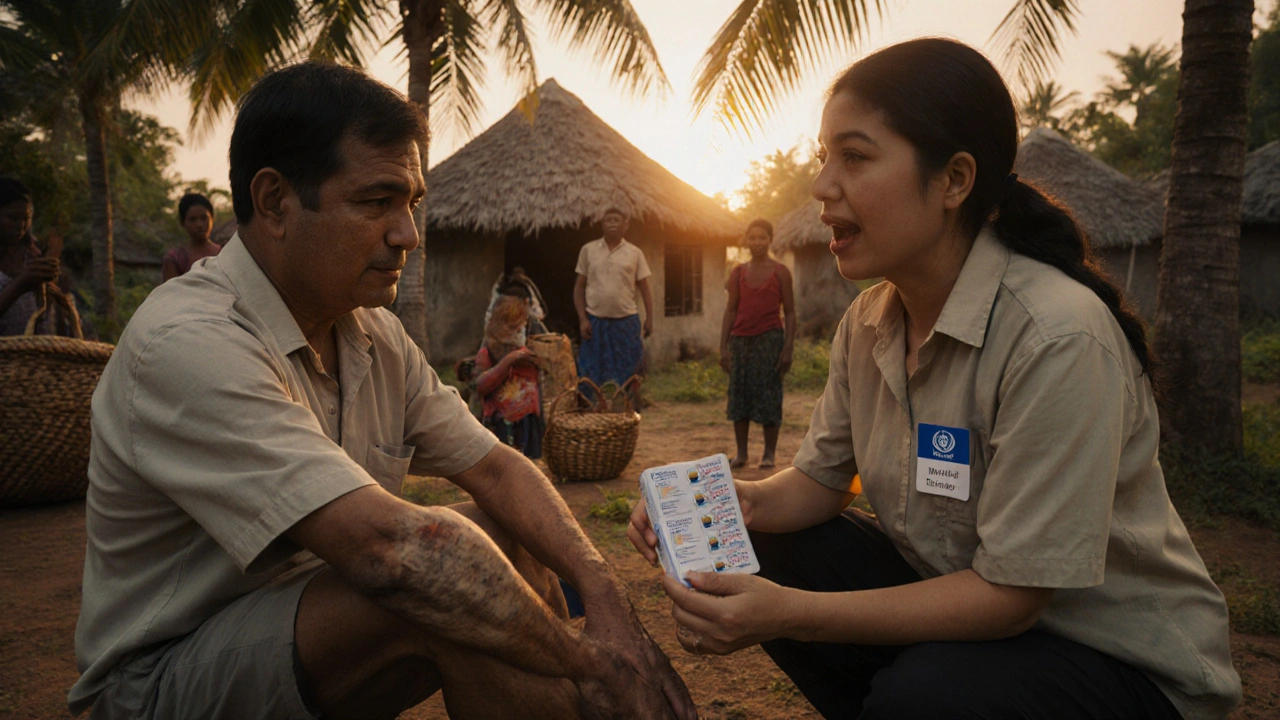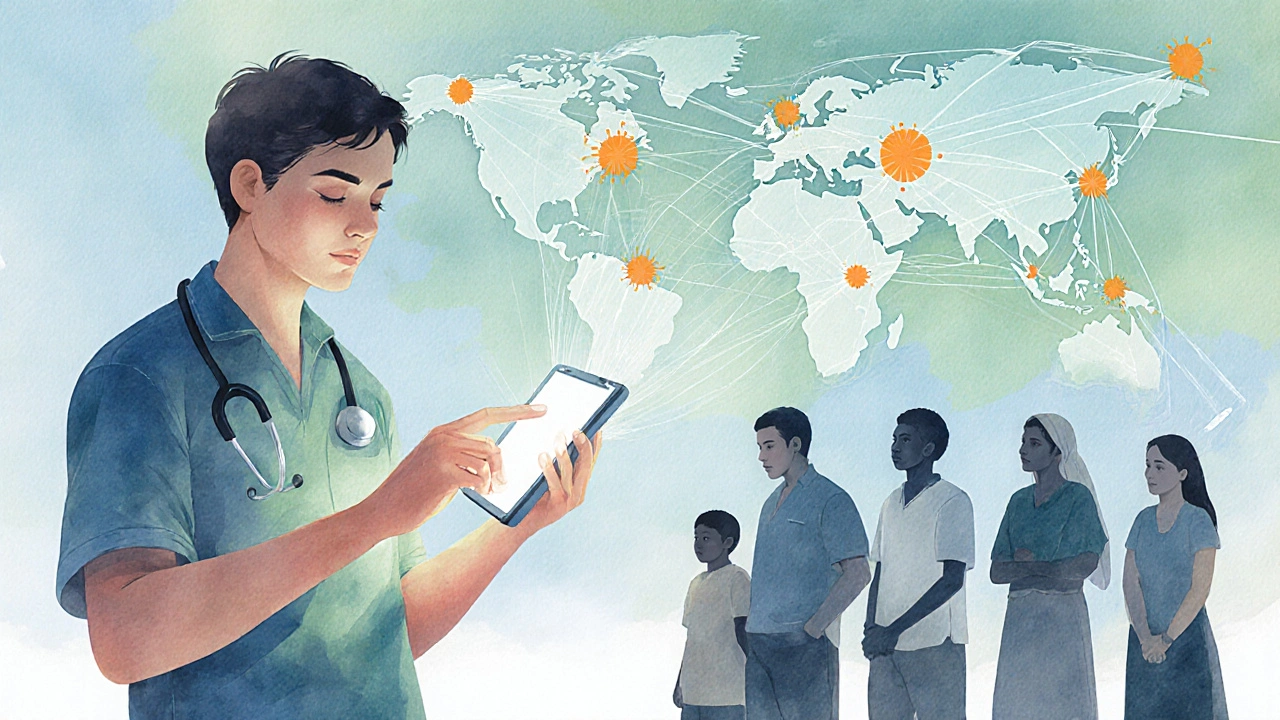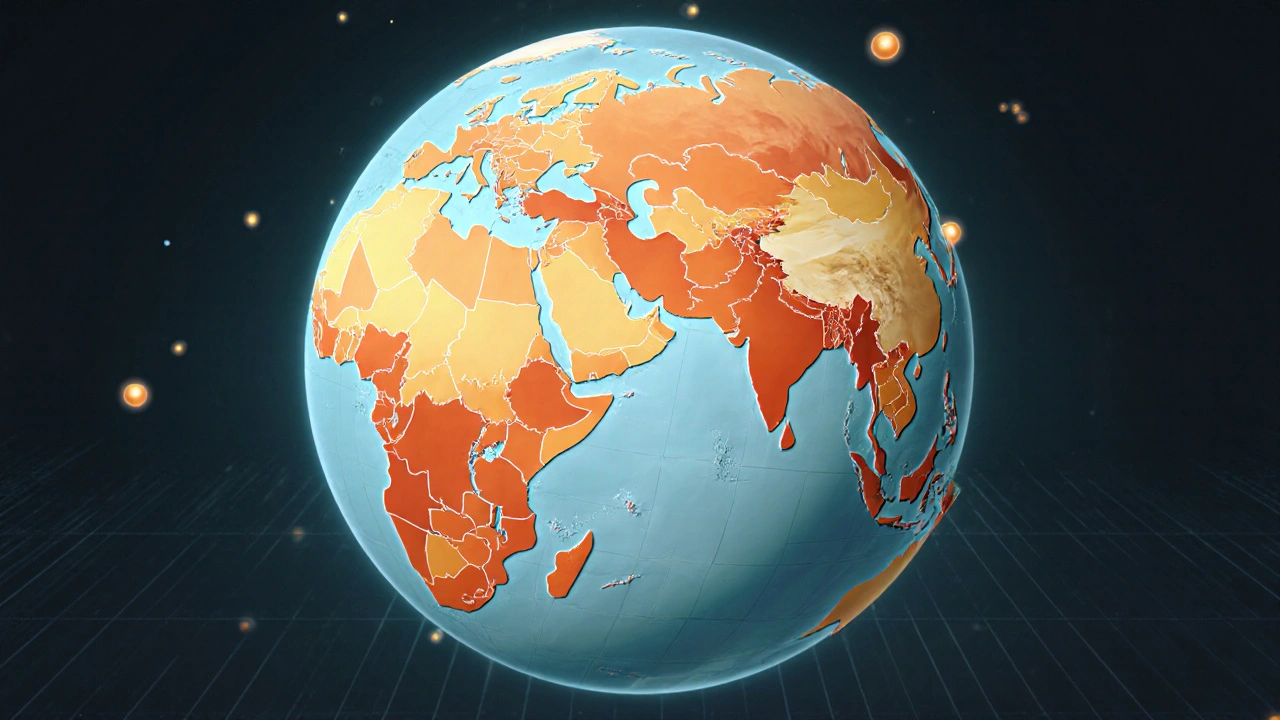Leprosy Global Statistics Explorer
147,000
New Cases (2024)
1.9/100,000
Incidence Rate
0.21/10,000
Prevalence Rate
80%
Top Countries Share
| Region | New Cases | Incidence (per 100,000) | Prevalence (per 10,000) |
|---|---|---|---|
| South-East Asia | 93,000 | 2.3 | 0.25 |
| Americas | 30,000 | 1.2 | 0.18 |
| Africa | 24,000 | 1.0 | 0.15 |
| Western Pacific | 0 | 0 | 0 |
Enter region and year to see updated statistics.
Quick Takeaways
- In 2024, the world reported ~147,000 new leprosy cases, a 7% drop from 2020.
- Prevalence fell to 0.21 cases per 10,000 people, comfortably below the WHO elimination target of 1 per 10,000.
- India, Brazil, and Indonesia together account for 80% of all cases.
- Multi‑drug therapy (MDT) remains >95% effective, but delayed diagnosis still fuels transmission.
- WHO’s 2025‑2030 strategy focuses on early case detection, stigma reduction, and surveillance upgrades.
What is Leprosy?
When we talk about Leprosy is a chronic infectious disease caused by the bacterium Mycobacterium leprae. The disease mainly attacks the skin, peripheral nerves, mucosa of the upper respiratory tract, and eyes, leading to skin patches, nerve damage, and sometimes severe disability if left untreated. It’s also known as Hansen’s disease, named after the Norwegian physician Gerhard Hansen who identified the causative agent in 1873. Despite its ancient reputation, modern treatment has turned leprosy from a death sentence into a curable condition.
Current Global Statistics (2024‑2025)
According to the latest World Health Organization (WHO) leprosy report, the world logged 147,000 new cases in 2024, down from 158,000 in 2020. That translates to an incidence of roughly 1.9 cases per 100,000 population, a modest but steady decline.
Overall prevalence - the number of people alive who are receiving treatment - now stands at about 202,000, or 0.21 cases per 10,000 people. This is well under the WHO elimination benchmark of 1 case per 10,000, a milestone first reached in 2001 and reaffirmed in subsequent years.
Key figures:
- Global incidence (2024): 1.9/100,000
- Global prevalence (2024): 0.21/10,000
- Mortality: < 0.5% (mostly due to severe complications or co‑infection)
- Age distribution: 60% of new cases are adults aged 15‑45
Regional Hotspots
While leprosy is now rare in most high‑income nations, it remains concentrated in a few regions:
| Region | New Cases | Incidence (per 100,000) | Prevalence (per 10,000) |
|---|---|---|---|
| South‑East Asia | 93,000 | 2.3 | 0.25 |
| Americas | 30,000 | 1.2 | 0.18 |
| Africa | 24,000 | 1.0 | 0.15 |
| Western Pacific | 0 | 0 | 0 |
The top three countries - India (55,000), Brazil (27,000), and Indonesia (13,000) - together contribute about 80% of global notifications.

How Trends Have Shifted Over the Last Decade
Looking back at the Global Burden of Disease (GBD) estimates, leprosy incidence dropped from 3.2/100,000 in 2010 to 1.9/100,000 in 2024, a 41% reduction. The biggest gains occurred between 2010‑2016, driven by massive scale‑up of MDT and nationwide case‑finding campaigns in high‑burden nations.
However, progress slowed after 2016. Two factors explain the plateau:
- Funding fatigue: International donors shifted priorities toward COVID‑19, malaria, and TB, cutting leprosy program budgets by ~15% from 2018‑2022.
- Stigma and late presentation: Even with free MDT, many patients delay seeking care until nerve damage is evident, sustaining hidden transmission chains.
These dynamics underscore why the WHO launched the Leprosy Strategy 2025‑2030. The new plan aims to cut annual incidence by 50% by 2030 using three pillars: active case detection, digital surveillance, and intensified community education.
Key Drivers Behind the Numbers
Understanding why Leprosy prevalence moves the way it does helps policymakers allocate resources wisely.
Effective Treatment: Multi‑drug Therapy (MDT)
Since its WHO endorsement in 1991, MDT-combining rifampicin, dapsone, and clofazimine-has cured >95% of patients when administered correctly. The regimen’s 6‑month course (for paucibacillary cases) and 12‑month course (for multibacillary cases) ensures rapid bacterial clearance, dramatically lowering transmission risk.
Surveillance Gaps
Many low‑resource districts still rely on passive case detection. Without active outreach, asymptomatic carriers remain invisible. Mobile health apps piloted in Brazil (2022) and India (2023) have improved reporting timeliness by 30%, but coverage remains under 60% in rural hotspots.
Social Determinants
Poverty, limited access to clean water, and crowded living conditions heighten exposure to Mycobacterium leprae. Moreover, stigma can force families to hide symptoms, delaying treatment and fueling ongoing spread.
Vaccination & Prophylaxis
The BCG vaccine, originally for TB, offers ~20% protection against leprosy. Recent trials of a single‑dose rifampicin post‑exposure prophylaxis (PEP) in Nepal showed a 57% reduction in new cases among close contacts. Scaling PEP could become a game‑changer, but cost and logistics are still hurdles.
Data Sources & Reliability
Most global numbers come from WHO’s annual leprosy report, which aggregates national notifications submitted by ministries of health. Complementary data are drawn from the GBD study, which applies statistical modelling to estimate under‑reporting.
Limitations to keep in mind:
- Under‑reporting: Some endemic countries lack robust health information systems, potentially missing up to 20% of cases.
- Case definition changes: In 2018, WHO refined the clinical case definition, causing a temporary dip in reported numbers that reflected classification, not true incidence.
- Stigma bias: Social stigma can lead to self‑exclusion from health registries.
Researchers cross‑validate WHO data with independent surveys (e.g., Indian National Leprosy Eradication Programme’s active surveys) to tighten confidence intervals.
Implications for Public Health Policy
Even with < 0.5% mortality and low prevalence, leprosy remains a public health priority for three reasons:
- Disability prevention: Untreated nerve damage causes lifelong impairment, affecting livelihoods and increasing healthcare costs.
- Transmission reservoirs: Hidden cases sustain low‑level transmission, threatening elimination goals.
- Human rights: Stigma violates dignity and can lead to discrimination in employment, marriage, and education.
Policy recommendations aligned with the 2025‑2030 strategy include:
- Invest in community health workers trained in skin‑lesion screening.
- Scale digital case‑reporting tools with offline capability.
- Integrate leprosy screening into routine primary‑care visits.
- Fund PEP trials in high‑risk neighborhoods.
- Launch anti‑stigma campaigns leveraging local faith leaders and schools.
Next Steps for Stakeholders
For health ministries: Review national surveillance dashboards quarterly, allocate budget for active case‑finding, and ensure MDT stockpiles are uninterrupted.
For NGOs: Partner with local clinics to provide counseling and vocational training for affected individuals.
For researchers: Focus on rapid diagnostic tests (RDTs) that can detect Mycobacterium leprae DNA from skin smears within minutes.
For donors: Prioritize funding mechanisms that lock in multi‑year commitments, shielding leprosy programs from global health crises.

Frequently Asked Questions
Is leprosy still contagious?
Yes, untreated leprosy can spread via droplets from the nose and mouth, especially during prolonged close contact. Effective MDT reduces contagiousness within weeks.
What are the early signs to watch for?
Early signs include faded skin patches, loss of sensation in hands or feet, and a tingling or burning feeling. Prompt skin‑smear testing confirms diagnosis.
How long does MDT treatment last?
For paucibacillary (few lesions) cases, MDT is given for 6months. Multibacillary (many lesions) cases require 12months of therapy.
Can leprosy be prevented?
Vaccination with BCG offers modest protection. The most effective preventative measure is early detection and treatment of contacts with single‑dose rifampicin PEP.
What is the current WHO goal for leprosy?
The WHO aims to reduce global incidence by 50% and eliminate grade‑2 disability in new cases by 2030, as outlined in the Leprosy Strategy 2025‑2030.


Ryan Smith
October 4, 2025 AT 18:18Sure, the WHO just loves to hide the real numbers for their own agenda.
John Carruth
October 12, 2025 AT 10:18First of all, I want to thank the author for compiling such a comprehensive overview of the current leprosy landscape; it's evident that a lot of effort went into gathering the regional breakdowns and historical trends. The decline from 3.2 to 1.9 cases per 100,000 over the past decade is encouraging, yet the plateau after 2016 signals that we need to double‑down on active case finding. I think it's crucial that ministries allocate dedicated funds for community health workers who can conduct skin‑lesion screenings, especially in high‑burden districts of India, Brazil, and Indonesia. Integrating digital reporting tools with offline capability will also help bridge the surveillance gaps you mentioned, allowing for near real‑time data uploads even in remote areas. Moreover, scaling up the single‑dose rifampicin post‑exposure prophylaxis (PEP) could dramatically cut transmission chains, provided we secure sustainable financing and address logistical hurdles. From a policy standpoint, I would recommend that donors consider multi‑year commitments to protect leprosy programs from the funding fatigue you highlighted, particularly as global health priorities shift. Finally, on the stigma front, partnering with local faith leaders and schools to run anti‑stigma campaigns can reshape community attitudes, which is essential for early detection and treatment adherence. Overall, your data-driven recommendations align well with the WHO 2025‑2030 strategy, and I hope stakeholders will act on these insights promptly.
Melodi Young
October 20, 2025 AT 02:18Honestly, the report skips over the fact that many countries still lack reliable lab capacity, so the numbers you cite are likely an under‑estimate. Also, you could've mentioned that WHO's definition change in 2018 caused a temporary dip that many readers might misinterpret as real progress.
Tanna Dunlap
October 27, 2025 AT 18:18It's appalling that we still have to discuss leprosy stigma in the 21st century; society should have already eradicated such prejudice. While the statistics show improvement, the moral imperative to protect the dignity of those affected remains unmet, and any public health plan must prioritize human rights alongside incidence reduction.
Troy Freund
November 4, 2025 AT 10:18When you look at disease trends, you can't help but notice the broader lesson: humanity's health is a mirror of our collective empathy. Leprosy's slow decline suggests that when we care enough to treat a disease, we can change its trajectory, but complacency will always reverse progress.
Mauricio Banvard
November 12, 2025 AT 02:18Let's be real: the pharma giants love MDT because it keeps them in the spotlight while the real cure-maybe a vaccine-gets buried under bureaucracy. The BCG's modest 20% protection is just a smokescreen; if the powers that be wanted to wipe leprosy out, they'd fund that research yesterday, not let us scramble with outdated regimens.
Paul Hughes
November 19, 2025 AT 18:18Great job pulling all these stats together 😊 It really helps us see where the gaps are and how we can pitch in, whether by volunteering for outreach or just spreading the word.